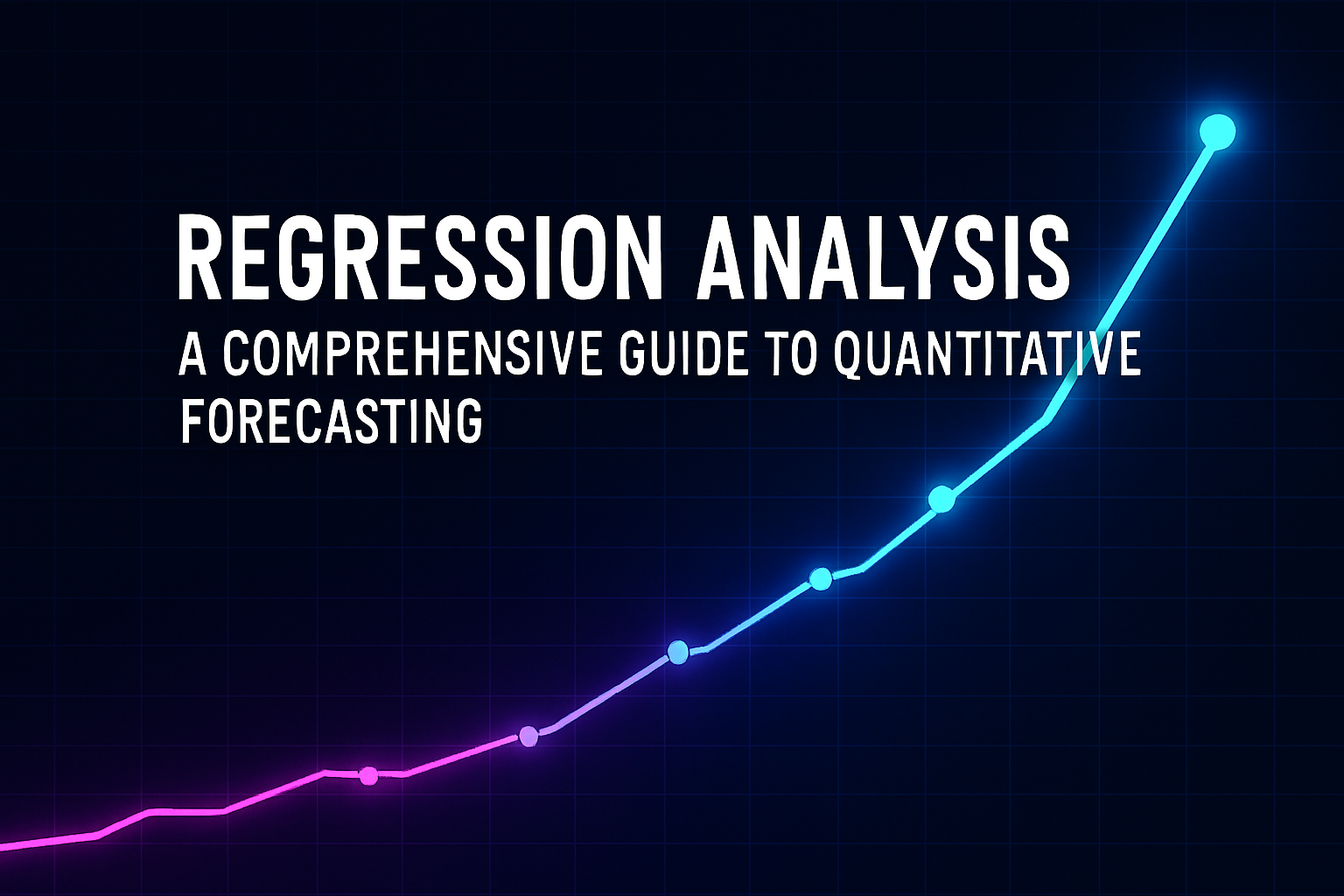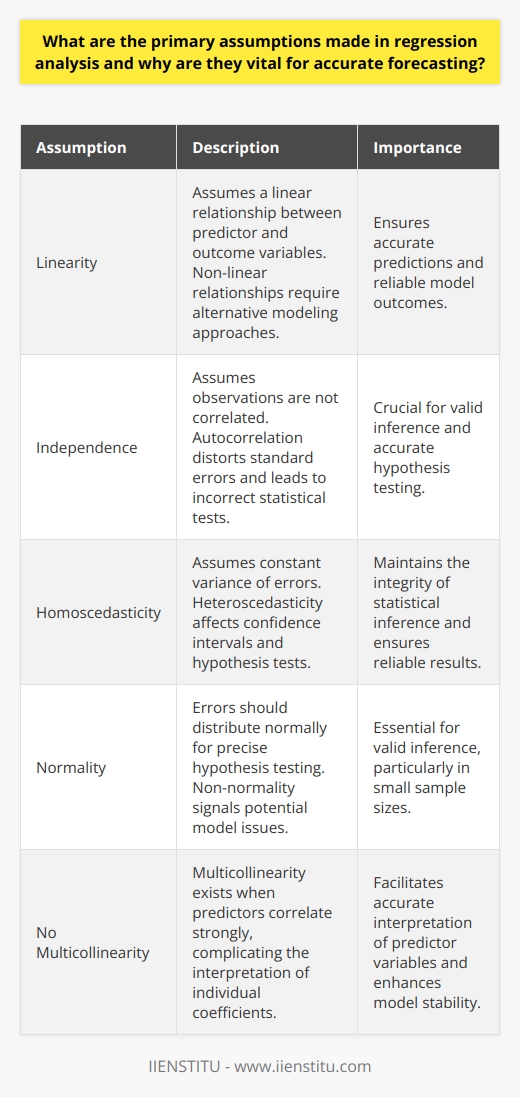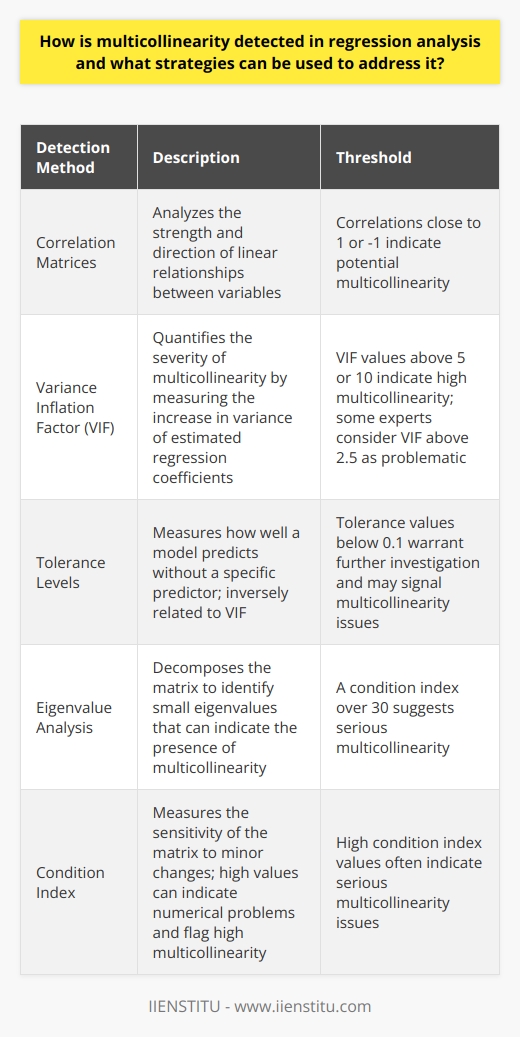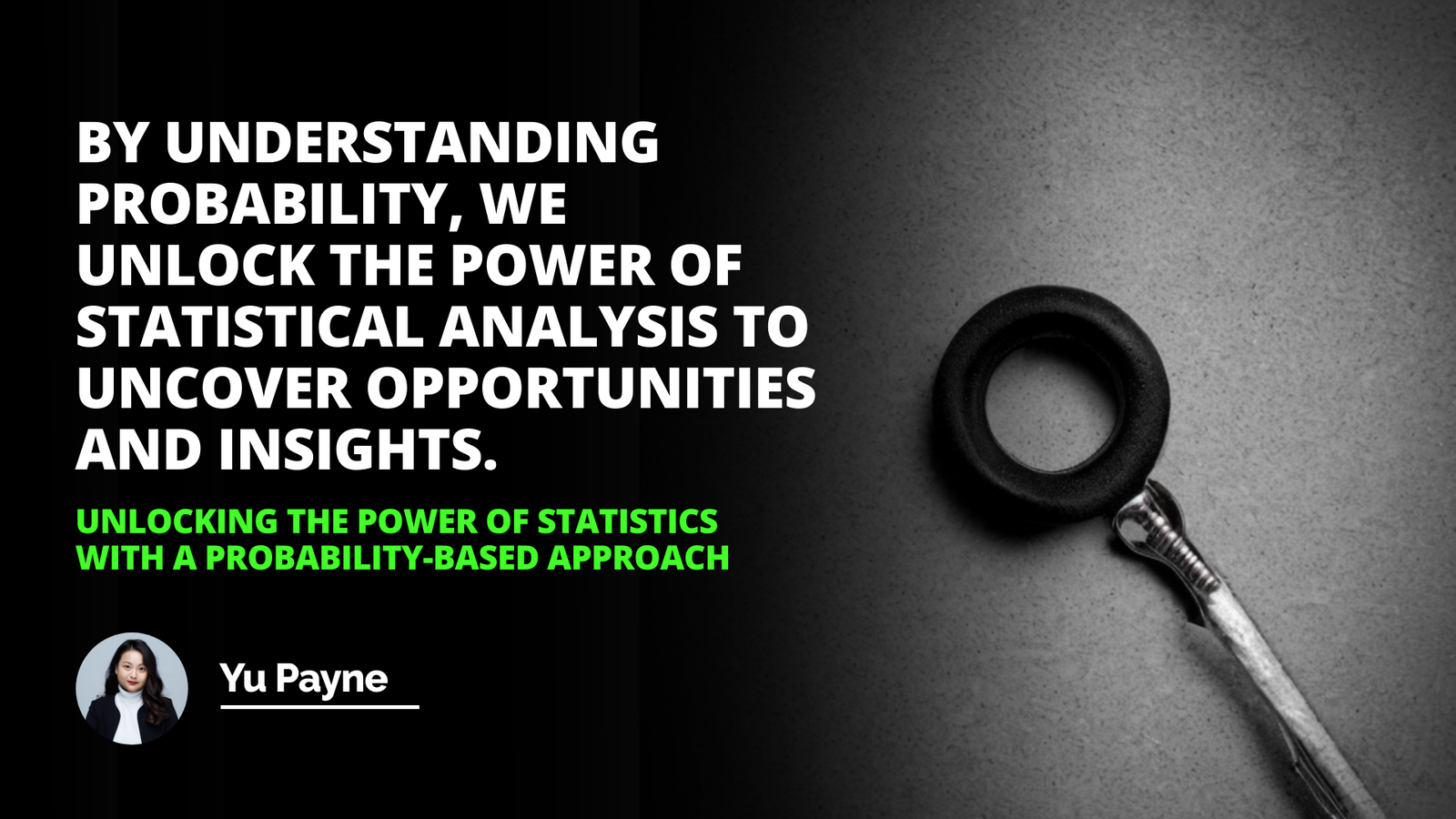
Regression analysis is one of the most useful. Whether you need to predict next quarter’s revenue, estimate hospital demand, or set optimal prices, regression turns raw historical data into structured forecasts you can defend.
This guide walks you through the what, why, and how of using regression for quantitative forecasting—without the statistical fog.
1. What Exactly Is Regression Analysis?
Regression analysis is a family of statistical methods that explains and predicts how an outcome (the dependent variable) changes when one or more factors (the independent variables) change.
Think of it as a mathematical “best-fit line”—straight or curved—drawn through past observations to reveal relationships you can project into the future.
2. Why Use Regression for Forecasting?
3. The Main Flavours of Regression
4. A Five-Step Workflow for Quantitative Forecasting
Step 1 — Define the Forecast Question
Bad: “I want to analyse sales.”
Good: “How many units will we sell per week in Q4 if we cut the price by 5 %?”
Step 2 — Assemble & Clean Data
Pull at least two full cycles (e.g., two years) if seasonality matters.
Align time stamps, fill or flag missing values, and verify units.
Step 3 — Explore & Choose Model Type
Plot trends, seasonality, and correlations.
Decide: linear, polynomial, or regularised (ridge/lasso) based on data shape and multicollinearity.
Step 4 — Fit, Validate, and Diagnose
Split data into training and test sets or use k-fold cross-validation.
Check assumptions: linearity, constant variance, independent errors.
Examine R², RMSE (or MAE), and residual plots.
Step 5 — Forecast & Communicate
Project the model into the forecast horizon.
Provide point forecasts and prediction intervals (“95 % chance weekly sales fall between 8 400 and 9 900 units”).
Translate coefficients into business terms: “Every extra ₺10 000 in digital ads adds ≈ 180 units the same week.”
5. Interpreting the Output—What Matters
6. Common Forecasting Pitfalls (and Fixes)
Assuming Linearity When It Isn’t
Fix: Add polynomial terms or switch to tree-based models.
Ignoring Multicollinearity
Fix: Use ridge or lasso; drop redundant predictors.
Overfitting With Too Many Variables
Fix: Cross-validate and penalise complexity.
Extrapolating Far Beyond Observed Data
Fix: Limit forecast horizon; refresh model frequently.
Confusing Correlation With Causation
Regression reveals associations; establish causality with experiments or instrumental variables.
7. Mini Case Study — Demand Forecast for a Coffee Chain
Goal
Forecast weekly cappuccino sales for the next 12 weeks.
Data
104 weeks of sales history
Weather (max temp, rainfall)
Promotions (binary flag)
Holidays (binary)
Google Trends index for “cappuccino”
Model
Multiple linear regression with:
Two seasonal dummies (summer, winter)
Lagged demand (last week’s sales)
Ridge penalty (λ chosen via cross-validation)
Actionable Insight
Scheduling promotions during cooler weekends should counter weather drag and lift weekly sales by ≈ 20 %.
8. When Regression Meets Machine Learning
Regularised models (ridge, lasso, elastic net) prevent over-fit when predictors > observations.
Gradient-boosted trees and random forests capture complex nonlinearities but sacrifice transparency.
Hybrid approach: use a transparent linear model for baseline forecasts and a tree-based model to flag anomalies.
9. Best Practices for Production Forecasting
Automate the Pipeline — schedule weekly data refresh and model refit.
Monitor Drift — alert when prediction error exceeds a threshold.
Version Control — store scripts and model artefacts in Git.
Document Everything — data sources, cleaning steps, and model assumptions.
Re-evaluate Quarterly — markets change; so should your model.
10. Further Reading
An Introduction to Statistical Learning — James et al., 3rd ed., 2023.
Forecasting: Principles and Practice — Hyndman & Athanasopoulos, 3rd ed., 2021 (free online).
Applied Linear Regression Models — Kutner et al., 5th ed., 2020.
Regression analysis offers a transparent, adaptable, and powerful route to quantitative forecasting. Master the fundamentals—sound data, the right model, honest validation—and you’ll turn historical noise into forecasts your team can rely on.
Frequently Asked Questions
What are the primary assumptions made in regression analysis and why are they vital for accurate forecasting?
Understanding Regression Analysis
Regression analysis stands as a statistical tool. It models relationships between variables. Forecasters and researchers rely on it heavily. For accurate forecasting, assumptions must hold true. Proper understanding of these assumptions ensures robust models.
Linearity Assumption
The linearity assumption is fundamental. It posits a linear relationship between predictor and outcome variables. When this assumption is violated, predictions become unreliable. Linearity can be checked with scatter plots or residual plots. Non-linear relationships require alternative modeling approaches.
Independence Assumption
Independence assumes observations are not correlated. When they are, we encounter autocorrelation. Autocorrelation distorts standard errors. This leads to incorrect statistical tests. Time series data often violate this assumption. Thus, special care is necessary in such analyses.
Homoscedasticity Assumption
Homoscedasticity implies constant variance of errors. Unequal variances, or heteroscedasticity, affect confidence intervals and hypothesis tests. This assumption can be scrutinized through residual plots. Corrective measures include transformations or robust standard errors.
Normality Assumption
Errors should distribute normally for precise hypothesis testing. Non-normality signals potential model issues. These may include incorrect specification or outliers. The normality assumption mainly affects small sample sizes.
No Multicollinearity Assumption
Multicollinearity exists when predictors correlate strongly. This complicates the interpretation of individual coefficients. Variance inflation factor (VIF) helps detect multicollinearity. High VIF values suggest a need to reconsider the model.
Why These Assumptions Matter
Assumptions in regression are not arbitrary. They cement the foundation for reliable results. Valid inference on coefficients depends on these. Accurate forecasting does too.
- Predictive Accuracy: Correct assumptions guide toward accurate predictions.
- Correct Inference: Meeting assumptions leads to valid hypothesis tests.
- Confidence in Results: Adhering to assumptions builds confidence in findings.
- Tool Selection: Awareness of assumptions guides the choice of statistical tools.
These conditions interlink to ensure that the regression models crafted produce outcomes close to reality. It is this adherence that transforms raw data into insightful, actionable forecasts. For those keen on extracting truth from numbers, the journey begins and ends with meeting these assumptions.

How is multicollinearity detected in regression analysis and what strategies can be used to address it?
Multicollinearity Detection
Detecting multicollinearity involves several statistical methods. Analysts often start with correlation matrices. Strong correlations suggest multicollinearity. Correlations close to 1 or -1 are red flags. Correlation coefficients represent the strength and direction of linear relationships. They range from -1 to 1. High absolute values indicate potential problems.
Variance Inflation Factor
Another key tool is the Variance Inflation Factor (VIF). VIF quantifies multicollinearity severity. It measures how much variance increases for estimated regression coefficients. VIF values above 5 or 10 indicate high multicollinearity. Some experts accept a lower threshold. They consider VIF above 2.5 as problematic.
Tolerance Levels
VIF relates inversely to tolerance. Tolerance measures how well a model predicts without a predictor. Low tolerance values suggest multicollinearity. Values below 0.1 often warrant further investigation. They can signal that the independent variable has multicollinearity issues.
Eigenvalue Analysis
Eigenvalue analysis offers deeper insight. It involves decomposing the matrix. Small eigenvalues can show multicollinearity presence. Analysts compare them to the condition index. A condition index over 30 suggests serious multicollinearity.
Condition Index
The condition index is crucial. It measures matrix sensitivity to minor changes. High values can indicate numerical problems. They often flag high multicollinearity.
Addressing Multicollinearity
Omit Variables
One strategy is to omit variables. Multicollinear variables may not all be necessary. Removing one can solve the problem. Depth in understanding the data guides this choice. It involves model simplification.
Combine Variables
Another method is to combine variables. This can involve creating indices or scores. It reduces the number of predictors. It combines related information into a single predictor.
Principal Component Analysis
Principal Component Analysis (PCA) is more complex. It creates uncorrelated predictors. PCA transforms the data into principal components. These components help maintain the information. They do so without multicollinearity.
Regularization Techniques
Regularization techniques like Ridge regression adjust coefficients. They shrink them towards zero. This can reduce multicollinearity impacts. It ensures better generalization for the model.
Increase Sample Size
Lastly, increasing the sample size can help. More data provides more information. It can reduce variance in the estimates. It also lowers the chances of finding false relationships.
Understanding and addressing multicollinearity strengthens regression analysis. It ensures valid, reliable, and interpretable models. Analysts must detect and remedy this issue to ensure clear conclusions. We can better understand how variables really relate to each other. With this insight, we make more accurate predictions and better decisions.

How are outliers identified and treated in regression analysis to ensure reliability of the forecast?
Outliers in Regression Analysis
Defining Outliers
Outliers present significant challenges in regression analysis. These are atypical observations. They deviate markedly from other data points. Analysts often spot them during preliminary data analysis. Outliers can distort predictions. They can affect the regression equation disproportionately. Accurate identification is crucial for reliable forecasting.
Identifying Outliers
Several methods aid outlier detection. Visual approaches include scatter plots. They allow quick outlier identification. Histograms and boxplots also serve this purpose. Statistical tests offer more precision. The Z-score method detects data points far from the mean. Grubbs' test identifies the most extreme outlier.
Standardizing Data
d-values standardize the difference between values. The interquartile range (IQR) method detects values beyond a threshold. Usually, these are 1.5 times the IQR above the third quartile. Or below the first quartile.
Treatment of Outliers
Once identified, several treatment options exist. Simplest is removal. This option suits clear errors or irrelevant data. Another approach involves transformation. It reduces the impact of extreme values. Logarithmic transformation is one example.
Advanced Methods
Robust regression techniques downplay outliers. They weigh them less in the analysis. This method maintains outlier inclusion while reducing influence. Winsorizing is another technique. It replaces extreme values. It uses the nearest value within the acceptable range.
Addressing Influential Points
Influential points affect regression results significantly. These outliers can skew regression lines dramatically. Cook’s Distance is a measure of influence. Analysts use it to assess each point's impact on the regression coefficients.
Testing and Validation
After outlier treatment, model reevaluation is necessary. One must check for improvement in model fit. Adjustments continue until the model shows robust predictive power. Cross-validation can assess the regression's reliability.
Conclusion
Outliers have major effects on regression analyses. Identifying and addressing them is key. Proper treatment ensures reliable and accurate forecasting. Analysts must balance outlier detection and treatment. This balance ensures the integrity of their models. It also prevents overfitting and maintains model validity.



